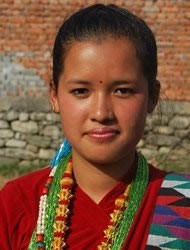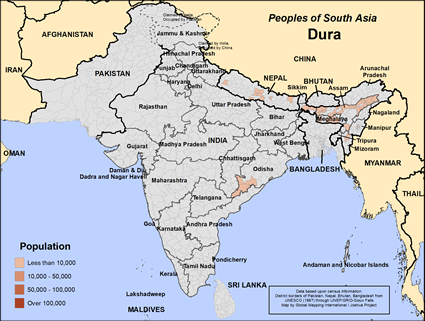Dura people inhabit the Lamjun District in the Gandakhi Zone of central Nepal. They were originally a group with their own Tibeto-Burman language. Like the better known Gurungs, the Dura have a military history behind them.
They migrated to their present location at various stages between the 8th and 12th centuries AD. At the time they had a far larger population than they do today. Over the course of the centuries the Dura area has been inundated with Hindus from the south. Gradually they lost the use of their mother tongue and now the Dura can only speak Nepali.
The Dura people live like most other rural peoples of Nepal. They grow grain as best they can and raise livestock for milk and meat.
Another part of their identity that is presently undergoing a process of assimilation is their religious belief. For centuries, Buddhism played the dominant role in Dura spiritual life. They lived at the southern end of the Tibetan Buddhist world, but after centuries of pressure from Hindu migrants, many of the Dura's Buddhist practices have now been subsumed into a complicated Hindu- Buddhist mix. The Dura worship many Hindu deities alongside images of Buddha.
The Dura still have lamas who serve the community's Buddhist needs, and most of their birth and funeral rituals are Buddhist in nature. When someone dies, a lama is summoned to 'perform the last rites and they do not do anything without their presence or permission '. It is noteworthy that the Dura go back to their Buddhist roots at times of death. On other important occasions, however, Hindu rituals are performed, especially matrimonial rituals that have been adopted from the Nepalis.
For more than a thousand years the Dura have been waiting to hear the gospel. In recent years a very small number have believed in Christ, but most of this fascinating group have yet to hear the good news.
Pray for the Lord to give the Dura people an abundant harvest this year as a testimony of his power and love.
Pray for the few Christians among them to be Christ bearers to their people.
Pray for spiritual hunger and discernment among the Dura people.
Scripture Prayers for the Dura in Nepal.
Peoples of the Buddhist World, Asia Harvest, Copyrighted © Used with permission
| Profile Source: Joshua Project |











